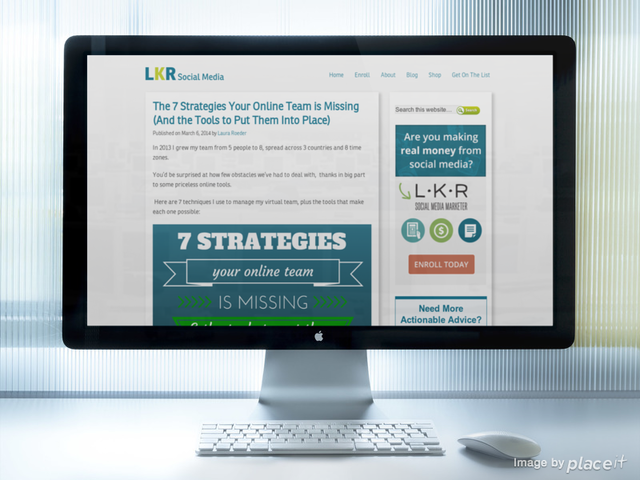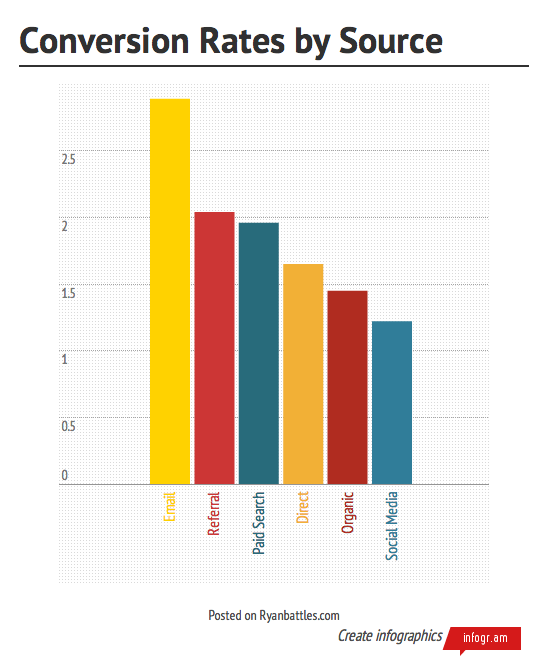
This is the first of what I hope to be an ongoing list of blogs and websites that I take a few minutes to analyze and pull out useful tips based on what the site creator is doing right. For my first of these types of posts, I turn to Laura Roeder’s successful blog, LKR Social Media.
I first noticed Laura’s site a few months back when a friend introduced me to some of her posts, and since then it seems like I’ve seen her everywhere. She’s appeared in just about every major publication and blog in her niche, and she’s created a handful of valuable information products that she sells via her site.

So, after reading through a few of her articles and jumping around her site, I’ve discovered 8 things that she is doing right, that I’m going to apply to my content marketing efforts either now or in the future.
1. Be More than a Blog
Blogging for the fun of it will only get you so far…a few weeks perhaps. The truth is, writing is a discipline, and something has to motivate you to continue to do it. For many of us, that motivation comes in the form of income…and blogging can become a quite lucrative lifestyle business for those who have stuck with it long enough and developed a following. Some bloggers use affiliate marketing to bring in income, and some, like Laura, have packaged up their knowledge into information products like books and courses.
I’m not talking about $12.99 Amazon purchases here, which eventually sold for $2.99 at the used bookstore. I’m talking about self-publishing content that sells for 5× or more than what you would pay for the same number of pages in an average book. The reason why bloggers can sell this information for much more is that they have already hooked you on their content by giving so much of it away for free on their blog. The content in their products is likely to be so targeted to what you need to learn, that whatever they are charging seems like a small price to pay compared to what you will take away from learning what lies within.
As for myself, I plan on eventually offering a product down the line, whether that is an edited collection of related blog posts enhanced with custom illustrations and charts or a series of video discussions with industry leaders. I’m not sure what that will be, but it is part of the reason why I am devoting myself to regular blogging at this point. Eventually, I will need this blog to contribute to my income either directly or indirectly.
However, for now, I’ll focus on creating epic content.
2. Create Compelling Headlines
Laura has multiple writers contributing to her blog, so for the sake of this article’s research I chose to focus on the most recent post written by Laura: The 7 Strategies Your Online Team is Missing (And the Tools to Put Them Into Place).
Immediately I noticed that Laura chooses her headlines carefully. She could have just as easily named this blog post one of these less “catchy” headlines:
- “Strategies for Online Teams”
- “Tools for Online Teams”
- “Tools that We Use to Manage an Online Team”
While these might be decent choices for long-tail keyword targeting, they probably would not draw in a lot of clicks when you come across them on Twitter, Google, or a blog post listing.
What Laura has done here is:
- Used a number in the title, indicating that it is a curated list post
- Provided a subtle warning (your team is missing something)
- Promises a solution (the tools to fix it)
By carefully choosing her title, she is much more likely to gain more traffic for this post when others come across its link.
Jon Morrow gives away a free ebook worth checking out if you are interested in learning more about what makes a catchy headline: 52 Headline Hacks, a Cheat Sheet for Writing Blog Posts that Go Viral.
3. Create Shareable Graphics
Most blogs publish an image with their posts…that’s an old tip. What I have found unique about LKR’s blog is that there is almost always a callout graphic created from something that the author just wrote or even the title of the post itself.

Sometimes I’m not sure what graphic would be appropriate to go along with the content that I write, but I can always create a graphic out of the text itself! If you aren’t skilled in graphic design, you can try your luck with someone on Fiverr, oDesk, or use one of these online tools:
Thanks to the boon of Pinterest, tools that allow you to paste in a quote and click your way to an attractive display abound.
4. Link Out to External Sources
Another tip that I’ve noticed from LKR’s blog is that the writers frequently link out of their blog to other sources. Why would we want to link out to another person’s website? Wouldn’t we lose our traffic?
Well, first of all, if you are writing good content, they’ll come back. They’ll want to read it. Secondly, your post becomes much more useful when readers can easily find other information with it.
Another benefit of linking out is that you are more likely to get on the radar of those to whom you are linking, as they will see your post in their analytics or Google alerts. While in many cases this won’t lead to anything, it might be a step towards networking professionally with others, which is always a good thing.
Finally, links in your post promote click-through…which Google likes to see. When someone visits your page and then clicks the back button instead of moving through to more content, that is called a “bounce”, and Google does take note of what search results lead to visitors bouncing back to the results page again.
5. Be Open to Discussion and Collaboration
As a blogger, you want an engaged audience. People leave comments on your blog because they want to add to the discussion or tell you something that was on their minds while reading. One of the ways to foster this type of discussion is to make people feel welcome to contribute to the discussion. Laura ended her post with the following:
If there’s a tool you use for running a team of remote people, I want to check it out and see if it might help me improve my management style, so please leave a link to it in the comments below!
As an authority in social media marketing, she could easily have taken the tone that she is the expert…listen to her! However, she specifically says “If there is a tool you use…I want to check it out.” What a great way to foster discussion and reader contributions.
6. Grow that Email List
There was a time when many content marketers ignored the email list. Instead of gaining Twitter followers, RSS Subscribers, or Facebook friends, we were in search of these vanity metrics to let us know how far our reach is.
As time has gone on, analytics have shown that while social media certainly drives traffic to the site, those visitors don’t convert as well as other sources. In a survey conducted by Optify.com, we find that email converts about twice as much as social media:

On LKR Social Media, the post ends with an email subscribe form. I particularly love the copy that comes along with the form:
Need more actionable advice? Get your FREE weekly marketing “to-do” list straight to your inbox every Wednesday:
What she does here is:
- Sets the expectation of what will happen if you give your email address
- Promises value (“actionable advice”)
- Ensures that you won’t get over-spammed (“every Wednesday”)
While crafting an email every week is optimal, you can also use Mailchimp to automatically send out an email based on an RSS feed whenever a new post is created, alleviating some of the extra work. As I said, it is optimal to craft this email by hand, but an automated one is better than none at all.
7. Show related posts & popular articles
People typically don’t buy from you after reading one article. The purpose of a blog is to build trust & authority, to be seen as a thought-leader and source of relevant information. After reading one of your posts, the audience might be hungry for more. Sure they could head back to your blog index and start browsing through your other posts, but it would be much easier if you would just provide what they are likely to want to read instead.
On LKR’s site, there are a handful of related posts at the end of the article, and her most popular posts are listed in the sidebar.
Again, giving your readers something to click through to will increase their engagement on the site, reduce your bounce rate, and enhance their perception of you as a trusted source. This leads to better search results and more conversions.
8. Be Omnipresent
The last tip that I want to highlight from LKR’s blog is that there are social media icons strategically placed within the layout. Not only does this encourage sharing of content with others, but also encourages connecting with LKR via social media channels.
Any blogger or content marketer should also be using Twitter, Facebook, LinkedIn, Pinterest, and Google+ to share content on those auxiliary channels.
At a very basic level, you can set up a profile and post a link to your content within those channels. This will lead to very low engagement and followers though. Developing a marketing strategy within these platforms involves regular time spent cultivating relationships and sharing useful information, especially from other sources so that you are not seen as overly self-promoting.
It can be time-consuming to maintain these profiles, but if they lead to a steady stream of new visitors to your site, the time and effort are worth it. I know I just said that social media doesn’t convert as well as email, but if you hook these social media visitors with your content, they will sign up for your email list as well.
Conclusion
As I mentioned before, I plan on pulling tidbits out of other people’s blogs as well in the future, as I tend to learn the most just by observing what others are doing in addition to reading article after article on how to be a better marketer & entrepreneur. LKR Social Media is a blogging site that has worked for one entrepreneur, chock-full of useful examples of what to do when designing and writing a blog.